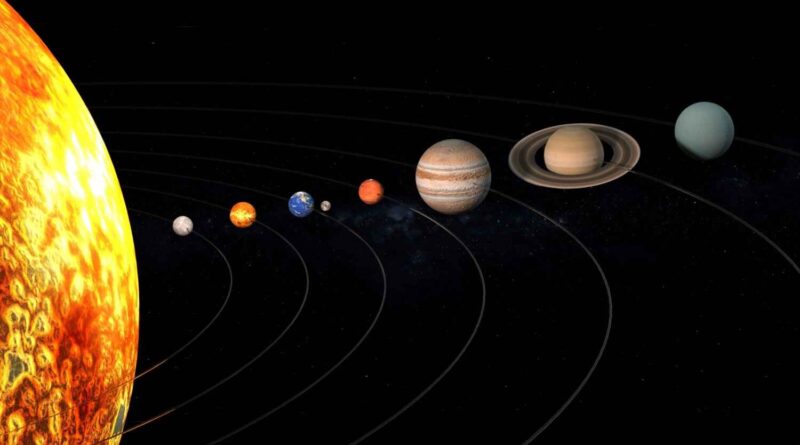Solar System the Universe in which we live
The Solar System circles the star that is called the Sun. Every planet and star in the Milky Way is moving around the Sun. There is gravity between them. It is also known as an interplanetary medium. The reason for calling it interplanetary medium is that it has icy bodies, cosmetics, a lot of asteroids with their satellites, and the vast, dusty, gassy tenuous. The solar system is a section of the observant universe, the area of space that scientists can deeply and mathematically observe with the help of technology. The universe is not a measurable and uncountable substance.
The moon and Sun are the Luminous and bright stars in the Solar System. Astronomers can easily see these two stars with the naked eye. Even every individual can see these two stars. The observation and the movement of the bodies give creation to astronomy. The variety of scientific devices has grown beyond the solar system to different planets and the edge of the well-known universe. The amount of information on the motions, characteristics, and compositions of planets and smaller bodies has a massive proportion today.
The Solar system and its nearest outer surround stand for the farthest boundaries of our physical comprehension. It continues to maintain our central focus of theoretical knowledge of the universe. Earth-launched spacecraft and landing crafts have collected information about the moon, space, and asteroids. This evidence has been complemented by measurements and made from above and below the Earth’s atmosphere. They use telescopic cameras and other instruments. The information is obtained from meteoroids and moon rocks that spacemen have returned. To understand all the details and data, this information is synchronized in the attempts to comprehend the origin and evolution of the solar system.
Chemistry of Solar System
The main center of the Solar System, the sun, which contains almost ninety-nine percent of the system’s mass, produces gravitational attraction force on all other bodies in its field of gravity. Some planets like Earth, Mercury, Venus, Mars, Neptune, Saturn, and Uranus are away from the sun. All the planets except Mercury and Venus have one or more than one moon, and the rest of them have the ring system. Since Pluto was discovered in 1930 it has been listed among the planets. But still in 1992, an icy object was discovered that is still farther from the Sun than Pluto. Many discoveries are shown in the Solar System. like for instance Eris is the massive object discovered and it is as large as Pluto. It was declared that Pluto is the largest member of the new group of objects, and it is collectively known as the Kuiper belt.
Relatively, in August 2006 the organization was charged by the scientific community with classified astronomical objects. The institute is called the International Astronomical Union. The decision was made, that Pluto should be removed from the planetary class and placed it to the tiny planet category.
Other Subject of Solar System
In the Solar System, rather than the Sun, a tiny planet, a planet, or a moon is called the small body, and meteoroids, asteroids, and comets are included. More than 1 million asteroids, or tiny planets, the asteroids are a roughly flat ring that forms on orbit ring between Mars and Jupiter. To distinguish them from the larger asteroidal bodies, many different asteroidal fragments and other tiny solid particles that are found in interplanetary space are commonly referred to as meteoroids.
Read more about Colonization in Space
The things from space between stars that are merely passing through can be found in the solar system. We have discovered 2 cosmic objects. Omuamua is clearly made from ammonic ice and has a peculiar form similar to a sugar or pancake. Similar to the solar system, comets Borisov had considerably higher carbon monoxide content.
Planets and different Moons
Concentrations or mass per unit volume can be used to separate the eight planets into 2 groups they are: the rocky compositions and densities of the 4 inner, natural planets. Earth, Mars, Venus, and Mercury exceed three grams per centimeter of surface area. The density of water is just 1 gram per cubic centimeter. Uranus, Neptune, Saturn, and Jupiter, are large objects with densities less than 2 grams per centimeter square. On the other hand, the rest of the outer planets are also known as Jovian, and giant planets are primarily composed of hydrogen and Helium for Jupiter and Saturn or ice rock, and Hydrogen and Helium are for Neptune and Uranus. As we already noted in this article, Pluto is also called a dwarf planet.

The majority of moons that have been identified circle their planets in the same direction that the planets do around the sun. They represent a great range of ecosystems and are incredibly diverse. Planet devastated by violent volcanism, orbits Jupiter, while Titan the largest moon of Saturn and a body bigger than the planet Mercury has the fundamental atmosphere thicker than the Earth.
The Beginning of the Solar System
Astronomers face additional difficulties in producing hypotheses according to the Solar System. They are facing such difficulties with the growing amount of data on planets, moons, comets, and asteroids. Theories of explanations for the origins of Earth and celestial objects are less grounded in reality and history. Indeed, it wasn’t until Newton’s theories of motion and gravity. The theory was published in 1687 and a scientific investigation into the solar system became possible.
After this discovery, Scientists are still facing difficulties in applying Newton’s Law. It has been difficult to explain the motion of asteroids, planets, moons, and comets for many years. Emanuel Swedenborg, a Swedish philosopher, proposed the scenario of the Sun shattered into smaller pieces to produce the planets. Immanuel Kant, a German philosopher, advanced the theory that the solar system formed from an initial nebula in 1755.
Conclusion
The basic hypothesis put forth by Kant was that the solar system originated as a cloud of scattered particles. He reasoned that after the particles began to move and collide due to their mutual gravitational pull, chemical forces held them together. These aggregates developed faster and faster until eventually they became the planets because some of them were larger than others. Kant was not very knowledgeable about physics or mathematics; therefore he was oblivious to the inherent drawbacks of his method. His concept does not explain the revolution of planetary satellites or the observable behavior of planets orbiting the Sun in the same plane and direction.
About forty years later, Pierre-Simon Laplace of France made a major advancement. Laplace was an exceptionally talented mathematician who achieved special achievement in the study of celestial mechanics. In addition to writing a significant treatise on the topic, Laplace penned a well-known book on astronomy that included an appendix with some theories regarding the solar system’s genesis.




